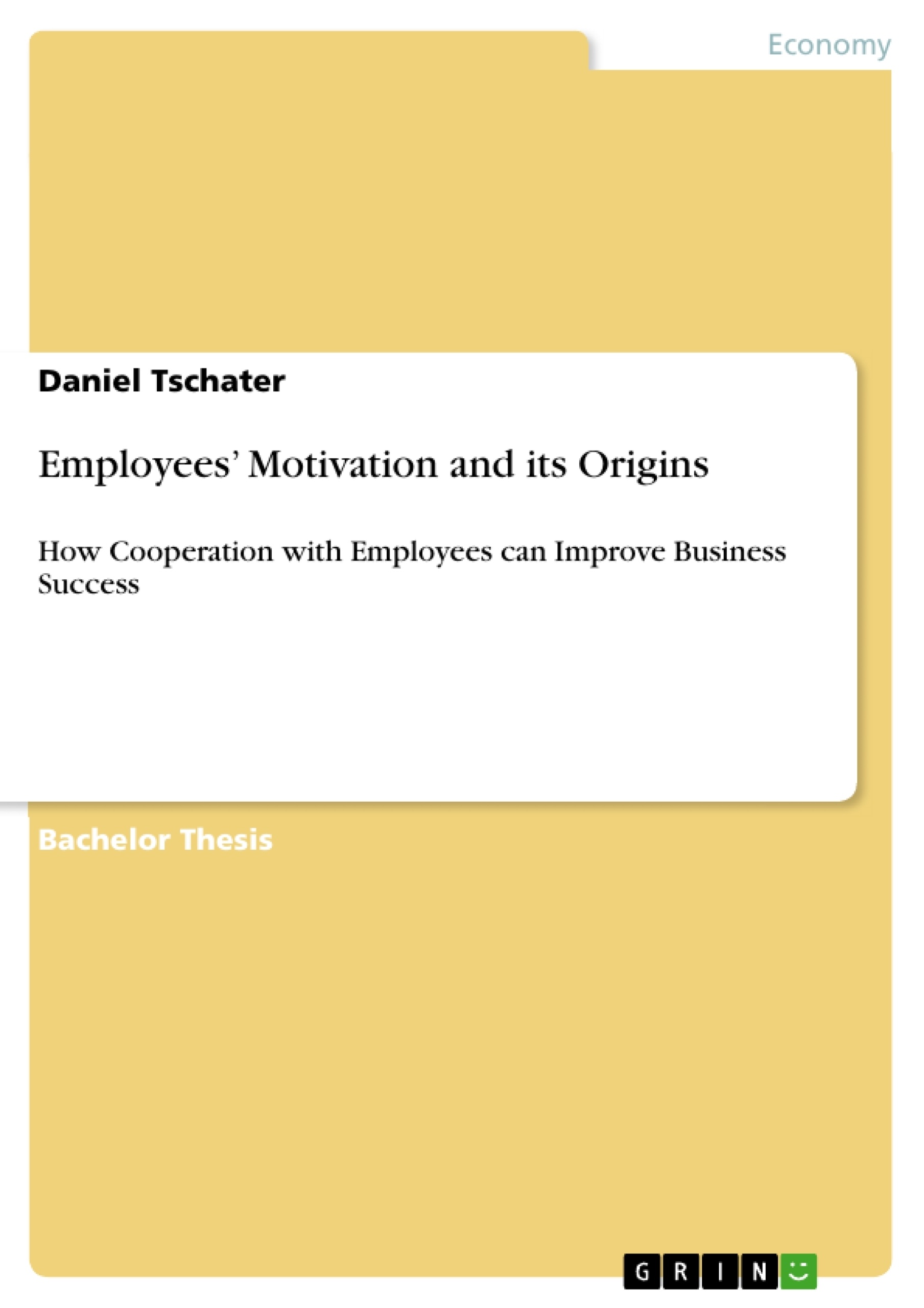This Bachelor thesis investigates the motivation of employees and its origins. It will figure out especially which factors influence people and how these factors influence the quality of peoples´ performance in their workplace.
Our times are shaped by a number of different bad influences that more and more create feelings of disaffection, insecurity and even fear.
There is a great increase of mental diseases beneath our population and even in situations less drastic, it one will find that people are more and more unhappy and disaffected by their situation even in their jobs.
Furthermore, it can be noticed that it seems as there are two sides in business society.
It seems as if managers on the one and employees on the other side are working in their own, separate environment and that both have a critical opinion towards the other.
For supervisors employees often are seen just as plodders that have to function and do what they are told. There is no space for the private situation of the employees in the office. Superiors often are seen as arbitrary, aloof and unfair.
Not only for the employees but as well for the companies this situation is not satisfying as they use much time and money to motivate their employees but, however, with only little success.
But as well occuring economical costs for the company will be investigated.
Our current society is facing a turning point.
It has to be investigated if rather the individual people have to change their mind and behaviour to satisfy the demands the companies pose to them or if the companies should reconsider if the way they manage their employees is the right one.
In fact in parts of our business society something is going wrong and this development leads to increasing dissatisfaction and frustration and thus to a decreasing of personal success on side of the employees and to decreasing of business success on side of the companies.
Table of Contents
- 1 Introduction
- 1.1 Occasion for Choice of the Subject
- 1.2 Objective Target of the Bachelor Thesis
- 2 Investigation of Peoples Needs and Motivation
- 2.1 The Myth of Motivating Employees
- 2.1.1 Motivating People – Yes we can?
- 2.1.2 Definition and Goals of Management by Motivation
- 2.2 Theoretical Approaches of Motivation
- 2.2.1 Motivation in Cultural Setting
- 2.2.1.1 Introductive Thoughts
- 2.2.1.2 A View on the Far East
- 2.2.1.3 The View of Peoples Self in the Hindu-Indian Culture
- 2.2.2 Discovering Peoples Needs
- 2.2.3 Motivation vs. Demotivation
- 2.2.4 Management's View on Employees Behaviour
- 2.3 Summary
- 3 The Actual Situation of Companies and Employees
- 3.1 Responsibility of the Companies
- 3.2 The Situation of the Working People
- 3.2.1 Formation of the Questionnaire
- 3.2.2 Block 1: Work Environment
- 3.2.3 Block 2: Communication
- 3.2.4 Block 3: Development Potentialities
- 3.2.5 Block 4: Personal Needs
- 3.2.6 Block 5: Relationship with Superiors
- 3.2.7 Block 6: Salary
- 3.2.8 Block 7: Common Questions
- 3.3 Negative Effects of not Paying Attention to Employees
- 3.3.1 Negative Effects on Side of the Employees
- 3.3.2 Negative Effects on Side of Company and Community
- 4 Other Management Instruments and Approaches
- 4.1 Trust as Basic Condition
- 4.2 The Importance of Communication
- 4.3 Different Approaches of Leadership
- 4.4 Other Possibilities to get Balanced Employees
- 5 Conclusion
Objectives and Key Themes
This Bachelor Thesis aims to investigate the importance of employee motivation for business success. It explores various theoretical perspectives on motivation, including cultural influences and individual needs. The thesis examines the practical implications of these theories, analyzing the actual situation of companies and employees, and the potential negative effects of neglecting employee motivation.- The Myth of Motivating Employees
- Theoretical Approaches to Motivation
- The Actual Situation of Companies and Employees
- Negative Effects of Neglecting Employee Motivation
- Management Instruments and Approaches to Foster Employee Motivation
Chapter Summaries
- Chapter 1: Introduction: This chapter establishes the subject of the thesis and defines its objective target. It outlines the importance of employee motivation in achieving business success.
- Chapter 2: Investigation of Peoples Needs and Motivation: This chapter explores the concept of motivation in a broader context, examining theoretical approaches and cultural influences. It delves into the importance of understanding individual needs in motivating employees.
- Chapter 3: The Actual Situation of Companies and Employees: This chapter analyzes the real-world situation of companies and employees, considering factors such as work environment, communication, and development potentialities. It explores the implications of various factors on employee motivation.
- Chapter 4: Other Management Instruments and Approaches: This chapter focuses on management practices and instruments that contribute to employee motivation. It discusses the importance of trust, communication, and different leadership styles in creating a positive work environment.
Keywords
This thesis explores the intersection of employee motivation, business success, cultural influences, management practices, and individual needs. It examines theoretical frameworks such as Maslow's Hierarchy of Needs and Herzberg's Two-Factor Theory, and explores the practical implications of these theories through an analysis of the actual situation of companies and employees.- Arbeit zitieren
- Daniel Tschater (Autor:in), 2010, Employees’ Motivation and its Origins, München, GRIN Verlag, https://www.grin.com/document/289143



